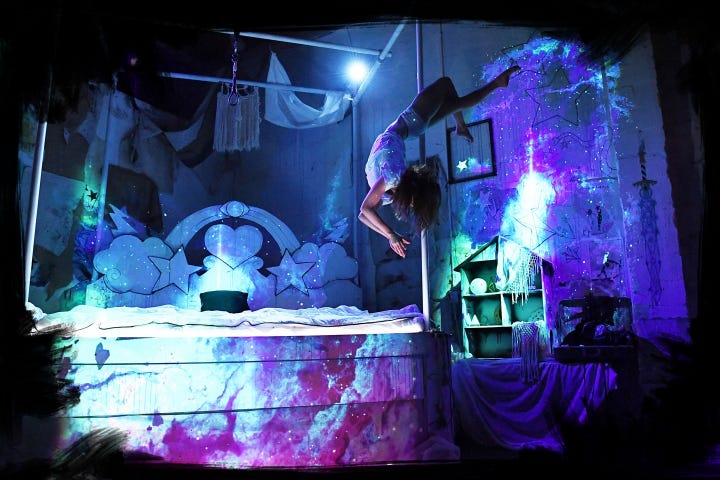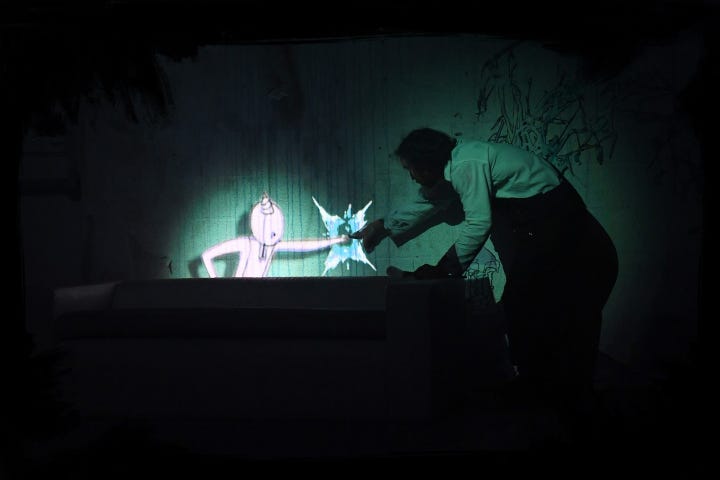The Immersive 5 with Particle Ink: Speed of Dark’s The Light Poets
Get into the mindset of the creators of Las Vegas’ most wondrous show


Mystique is often the name of the game in immersive, with creators crafting elaborate mythologies for their works and even alternate identities for themselves. Particle Ink: Speed of Dark, which is currently wowing audiences in Las Vegas with its tight mix of animated projection mapping, world-class circus arts, and dark fantasy storytelling, goes for both. Not only is Speed of Dark positioned as one part of a larger story universe, but the creators themselves work under the collective name of the LightPoets.
In this, the return of NoPro’s Immersive 5, we explore The LightPoets’ approach to crafting a work of immersive wonder.
The Immersive 5 series asks creators across the various immersive disciplines the same five questions in search of both their approach to crafting work, and the elusive nature of immersive work itself.

No Proscenium: What does “immersive” mean to you, and what terms do you use when talking about your own work?
The LightPoets: Immersive is a completely transportive experience. This can take the form of creating a complete physical environment, or a virtual environment or it can be an exceptional radio drama with incredible speakers/headphones that convinces the audience that they are in a new place… something that lives and breathes all around them. We (the LightPoets) use a lot of technology within our work and I think that creates a different dynamic for our audience — we encourage them to actively participate within the story, so it becomes more than just exploring.
Get Noah J Nelson’s stories in your inbox
Join Medium for free to get updates from this writer.
SubscribeSubscribe
Our live experience mixes environmental design, projection mapping, with augmented reality. These elements when put together, both immerse the audience, but further the story and the world of the universe. The technology is used very specifically to serve that purpose, and is not used for the sake of showing off technology. Part of what we hope to do with this universe is take it out of the live experience and enable people to access it through their own mobile device. At this point, AR is not immersive in our minds. It is interactive; the audience interacts with it and the AR, in turn, interacts with the foreign environment it has been introduced to. When we describe our work, we use the terms immersive and/or interactive.
NP: What should every creator be thinking about first and foremost when designing for the audience?
LP: The challenging part is there is no first and foremost when designing for an audience in this kind of work. There are a number of things that have to all be considered together in order to create, what we believe, is a satisfying experience. That list includes: what type of experience/venue is this (pop up, sit down, tour, theatre, warehouse, field) what does this world look like, who are the characters, what is the story we are telling, how do we want the audience to interact with the story (how close do they get to things, can they pick up things etc), how much of the story do they need to experience if any, how do we keep them and the performers safe. Obviously, budget plays into this too and has a huge impact.
NP: What did you wish you knew when you were starting out with this stuff and what’s the one thing you’d tell a creator starting out today?
LP: Most people don’t have the ability to visualize space and see, imaginatively, things in 3D. We visualize space and imagine things in 3D. But after battles with collaborators, producers and so forth, we quickly realized that it was difficult to get people to imagine the same thing even when (we think) it is relatively simple. When it is something as complex as an entire new world, you really need to make sure you are ready to draw, present photos or other visual aids. The world and environment are so important that you have to be very, very clear from the moment you present a new idea of how that part will look. You can’t just write a script, you have to create a picture book if you want people to truly understand what the vision is.
NP: Why do this kind of work and not something more “traditional” that might have more mainstream appeal at the moment?
LP: Our interest in this work has really come from a desire to create a different relationship between audience and story/theatre work. A lot of artists believe that we can change social consciousness, how people think, approach or interact with each other. But watching theatre, in the traditional sense, puts people in a passive position. They are outside of it. They can consider what is happening on stage and they can believe that they would respond differently, but they aren’t necessarily thrown into it. The exciting part of immersive theatre is that people very quickly learn what kind of person they are and exactly how they would respond in certain circumstances. Their place in the story is often much more active. Consequently, we believe that immersive theatre has the ability to change social consciousness at a faster rate than previous art forms.
NP: What inspirations — and anything is fair game here — are currently shaping your creative practice?
LP: The LightPoets are a collective of artists from different disciplines and backgrounds. Artists don’t ever stop seeking inspiration. We look for it everywhere and in everything — podcasts, a visual artist, a new form of physical movement, technology, music, film, instagram, a quote, politics…What’s important is then taking that inspiration and figuring how it converges with ‘play’. And what we mean by that, is what is it in a piece that brings people together and makes them want to interact with each other and play. When people truly interact and play, they discover things, moments, that can be at the core of the original intention that really captures the artist’s original moment of inspiration. The exciting aspect of immersive theatre is that it creates a space where an audience can actually be invited into that process too (to a degree). Suddenly the audience isn’t watching something that is inspired, but they are finding their own inspiration as they connect with others. This is also reflected in how our work is about connecting to the inner child. Creativity and connection are the two most important gifts of humanity and that we could fix the majority of our problems if we got better at these.
Particle Ink: Speed of Dark is now playing in Las Vegas, and currently booking through Oct. 9th, 2022.
For more on the show read our review, and listen to our interview with producer Cesar Hawas.
Discover the latest immersive events, festivals, workshops, and more at our new site EVERYTHING IMMERSIVE, new home of NoPro’s show listings.
NoPro is a labor of love made possible by our generous Patreon backers. Join them today!
In addition to the No Proscenium website, our podcast, and our newsletters, you can find NoPro on Twitter, Facebook, YouTube, Instagram, in the Facebook community Everything Immersive, and on our Discord.